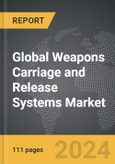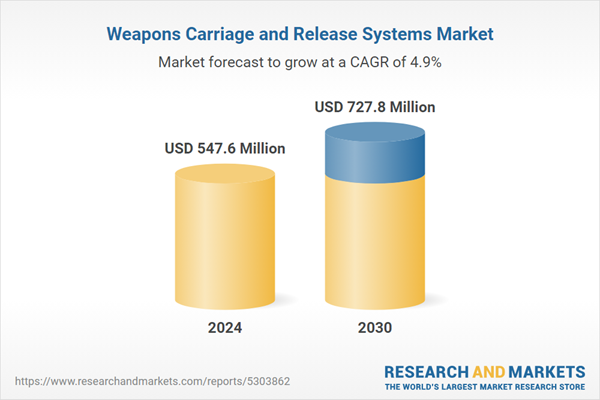The global market for Weapons Carriage and Release Systems was valued at US$547.6 Million in 2024 and is projected to reach US$727.8 Million by 2030, growing at a CAGR of 4.9% from 2024 to 2030. This comprehensive report provides an in-depth analysis of market trends, drivers, and forecasts, helping you make informed business decisions. The report includes the most recent global tariff developments and how they impact the Weapons Carriage and Release Systems market.
The primary growth drivers for the weapons carriage and release systems market include increasing global defense expenditures, the modernization of military fleets, and heightened geopolitical tensions prompting nations to strengthen their defense capabilities. As countries modernize their air and naval forces, there is a significant push to upgrade existing systems with more advanced, precision-based technologies that can handle a wider range of weaponry. Additionally, the rise of unmanned aerial vehicles (UAVs) has expanded the market, as these platforms require specialized, lightweight release systems that can operate autonomously. The growing emphasis on multi-domain operations, where forces operate in a coordinated manner across different fields of battle, also drives the need for versatile and reliable weapons release systems that can be integrated across various platforms.
The incorporation of advanced materials such as high-strength composites and lightweight alloys is a transformative trend in the weapons carriage and release systems market. These materials contribute to reducing the overall weight of the systems, which is particularly crucial for aircraft performance, allowing for greater payload capacity and fuel efficiency. Additionally, the integration of smart technologies, including digital sensors and networked systems, enhances the functionality of these systems. Such technologies enable more precise weapon deployment, real-time monitoring, and better adaptability to changing combat scenarios. This technological evolution not only increases operational effectiveness but also significantly boosts the reliability and safety of missions by minimizing the risks of mechanical failures. The future of weapons carriage and release systems is likely to see continued innovation in materials science and digital technologies. As military operations become more technology-driven, the demand for highly integrated, smart systems capable of interfacing seamlessly with other military assets will increase. Moreover, the ongoing expansion of UAV applications in military contexts will keep driving the demand for specialized carriage and release systems, shaping the strategic priorities of defense technology developers. Moreover, as defense strategies increasingly focus on reducing human risk in combat zones, the demand for advanced automated release systems capable of remote operation is expected to grow, shaping future technological advancements in this field.
Segments: Platform (Fighter Aircrafts, Combat Support Aircrafts, Helicopters, UAVs); Weapon Type (Missiles, Bombs, Rockets, Torpedoes); End-Use (OEMs, Aftermarket).
Geographic Regions/Countries: World; United States; Canada; Japan; China; Europe (France; Germany; Italy; United Kingdom; Spain; Russia; and Rest of Europe); Asia-Pacific (Australia; India; South Korea; and Rest of Asia-Pacific); Latin America (Argentina; Brazil; Mexico; and Rest of Latin America); Middle East (Iran; Israel; Saudi Arabia; United Arab Emirates; and Rest of Middle East); and Africa.
The analysts continuously track trade developments worldwide, drawing insights from leading global economists and over 200 industry and policy institutions, including think tanks, trade organizations, and national economic advisory bodies. This intelligence is integrated into forecasting models to provide timely, data-driven analysis of emerging risks and opportunities.
Global Weapons Carriage and Release Systems Market - Key Trends and Drivers Summarized
Weapons carriage and release systems are specialized mechanisms installed on military aircraft, drones, and naval vessels to transport, secure, and deploy various types of munitions, including bombs, missiles, and torpedoes. These systems are crucial for managing the payload in combat and strategic operations, ensuring that weapons are safely carried and effectively released at the target. The effectiveness, reliability, and adaptability of these systems are critical for mission success, influencing their design and technological evolution.The primary growth drivers for the weapons carriage and release systems market include increasing global defense expenditures, the modernization of military fleets, and heightened geopolitical tensions prompting nations to strengthen their defense capabilities. As countries modernize their air and naval forces, there is a significant push to upgrade existing systems with more advanced, precision-based technologies that can handle a wider range of weaponry. Additionally, the rise of unmanned aerial vehicles (UAVs) has expanded the market, as these platforms require specialized, lightweight release systems that can operate autonomously. The growing emphasis on multi-domain operations, where forces operate in a coordinated manner across different fields of battle, also drives the need for versatile and reliable weapons release systems that can be integrated across various platforms.
The incorporation of advanced materials such as high-strength composites and lightweight alloys is a transformative trend in the weapons carriage and release systems market. These materials contribute to reducing the overall weight of the systems, which is particularly crucial for aircraft performance, allowing for greater payload capacity and fuel efficiency. Additionally, the integration of smart technologies, including digital sensors and networked systems, enhances the functionality of these systems. Such technologies enable more precise weapon deployment, real-time monitoring, and better adaptability to changing combat scenarios. This technological evolution not only increases operational effectiveness but also significantly boosts the reliability and safety of missions by minimizing the risks of mechanical failures. The future of weapons carriage and release systems is likely to see continued innovation in materials science and digital technologies. As military operations become more technology-driven, the demand for highly integrated, smart systems capable of interfacing seamlessly with other military assets will increase. Moreover, the ongoing expansion of UAV applications in military contexts will keep driving the demand for specialized carriage and release systems, shaping the strategic priorities of defense technology developers. Moreover, as defense strategies increasingly focus on reducing human risk in combat zones, the demand for advanced automated release systems capable of remote operation is expected to grow, shaping future technological advancements in this field.
Report Scope
The report analyzes the Weapons Carriage and Release Systems market, presented in terms of units. The analysis covers the key segments and geographic regions outlined below.Segments: Platform (Fighter Aircrafts, Combat Support Aircrafts, Helicopters, UAVs); Weapon Type (Missiles, Bombs, Rockets, Torpedoes); End-Use (OEMs, Aftermarket).
Geographic Regions/Countries: World; United States; Canada; Japan; China; Europe (France; Germany; Italy; United Kingdom; Spain; Russia; and Rest of Europe); Asia-Pacific (Australia; India; South Korea; and Rest of Asia-Pacific); Latin America (Argentina; Brazil; Mexico; and Rest of Latin America); Middle East (Iran; Israel; Saudi Arabia; United Arab Emirates; and Rest of Middle East); and Africa.
Key Insights:
- Market Growth: Understand the significant growth trajectory of the Fighter Aircrafts segment, which is expected to reach US$256.5 Million by 2030 with a CAGR of a 4.8%. The Combat Support Aircrafts segment is also set to grow at 5.3% CAGR over the analysis period.
- Regional Analysis: Gain insights into the U.S. market, valued at $143.4 Million in 2024, and China, forecasted to grow at an impressive 7.5% CAGR to reach $159.9 Million by 2030. Discover growth trends in other key regions, including Japan, Canada, Germany, and the Asia-Pacific.
Why You Should Buy This Report:
- Detailed Market Analysis: Access a thorough analysis of the Global Weapons Carriage and Release Systems Market, covering all major geographic regions and market segments.
- Competitive Insights: Get an overview of the competitive landscape, including the market presence of major players across different geographies.
- Future Trends and Drivers: Understand the key trends and drivers shaping the future of the Global Weapons Carriage and Release Systems Market.
- Actionable Insights: Benefit from actionable insights that can help you identify new revenue opportunities and make strategic business decisions.
Key Questions Answered:
- How is the Global Weapons Carriage and Release Systems Market expected to evolve by 2030?
- What are the main drivers and restraints affecting the market?
- Which market segments will grow the most over the forecast period?
- How will market shares for different regions and segments change by 2030?
- Who are the leading players in the market, and what are their prospects?
Report Features:
- Comprehensive Market Data: Independent analysis of annual sales and market forecasts in US$ Million from 2024 to 2030.
- In-Depth Regional Analysis: Detailed insights into key markets, including the U.S., China, Japan, Canada, Europe, Asia-Pacific, Latin America, Middle East, and Africa.
- Company Profiles: Coverage of players such as Alkan, Cobham PLC, Ferra Engineering Pty LTD, Harris Corporation, Marotta Controls and more.
- Complimentary Updates: Receive free report updates for one year to keep you informed of the latest market developments.
Some of the 78 companies featured in this Weapons Carriage and Release Systems market report include:
- Alkan
- Cobham PLC
- Ferra Engineering Pty LTD
- Harris Corporation
- Marotta Controls
- Marvin Group
- Moog, Inc.
- Rafaut Group
- Raytheon Company
- Ruag Group
Tariff Impact Analysis: Key Insights for 2025
Global tariff negotiations across 180+ countries are reshaping supply chains, costs, and competitiveness. This report reflects the latest developments as of April 2025 and incorporates forward-looking insights into the market outlook.The analysts continuously track trade developments worldwide, drawing insights from leading global economists and over 200 industry and policy institutions, including think tanks, trade organizations, and national economic advisory bodies. This intelligence is integrated into forecasting models to provide timely, data-driven analysis of emerging risks and opportunities.
What’s Included in This Edition:
- Tariff-adjusted market forecasts by region and segment
- Analysis of cost and supply chain implications by sourcing and trade exposure
- Strategic insights into geographic shifts
Buyers receive a free July 2025 update with:
- Finalized tariff impacts and new trade agreement effects
- Updated projections reflecting global sourcing and cost shifts
- Expanded country-specific coverage across the industry
Table of Contents
I. METHODOLOGYII. EXECUTIVE SUMMARY2. FOCUS ON SELECT PLAYERSIII. MARKET ANALYSISCANADAITALYSPAINRUSSIAREST OF EUROPESOUTH KOREAREST OF ASIA-PACIFICARGENTINABRAZILMEXICOREST OF LATIN AMERICAIRANISRAELSAUDI ARABIAUNITED ARAB EMIRATESREST OF MIDDLE EASTIV. COMPETITION
1. MARKET OVERVIEW
3. MARKET TRENDS & DRIVERS
4. GLOBAL MARKET PERSPECTIVE
UNITED STATES
JAPAN
CHINA
EUROPE
FRANCE
GERMANY
UNITED KINGDOM
ASIA-PACIFIC
AUSTRALIA
INDIA
LATIN AMERICA
MIDDLE EAST
AFRICA
Companies Mentioned (Partial List)
A selection of companies mentioned in this report includes, but is not limited to:
- Alkan
- Cobham PLC
- Ferra Engineering Pty LTD
- Harris Corporation
- Marotta Controls
- Marvin Group
- Moog, Inc.
- Rafaut Group
- Raytheon Company
- Ruag Group
Table Information
| Report Attribute | Details |
|---|---|
| No. of Pages | 111 |
| Published | April 2025 |
| Forecast Period | 2024 - 2030 |
| Estimated Market Value ( USD | $ 547.6 Million |
| Forecasted Market Value ( USD | $ 727.8 Million |
| Compound Annual Growth Rate | 4.9% |
| Regions Covered | Global |









